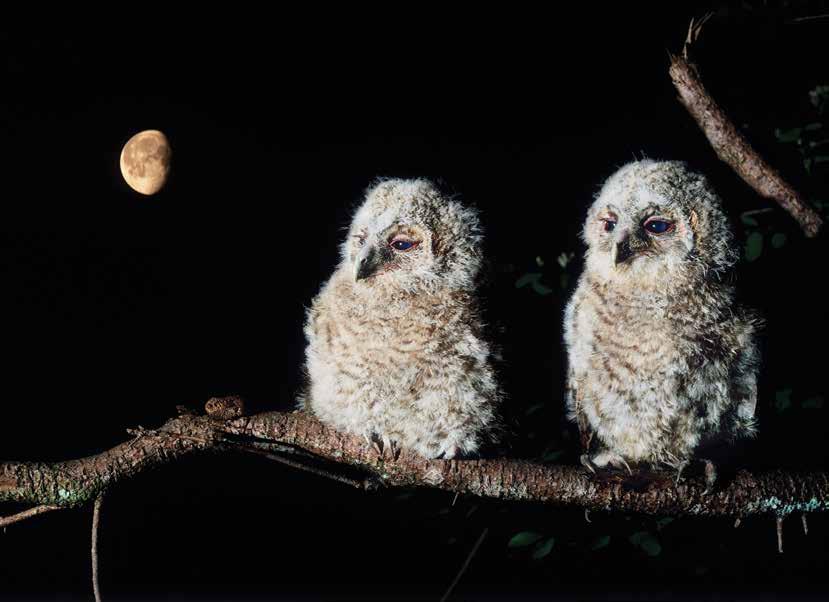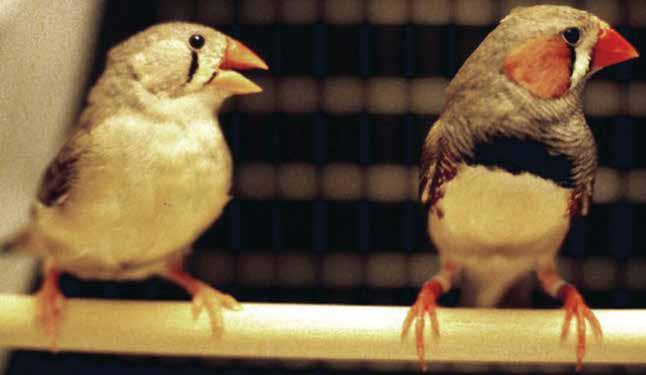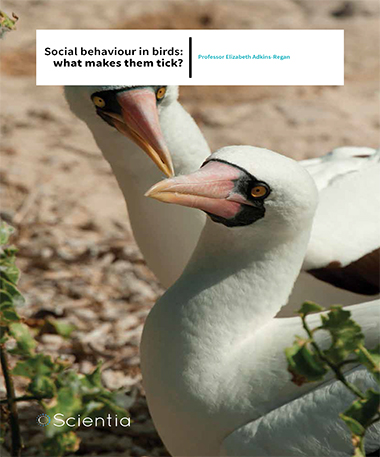Professor Elizabeth Adkins-Regan – Social Behaviour In Birds: What Makes Them Tick?
Professor Elizabeth Adkins-Regan of Cornell University investigates the physiological mechanisms underlying social and reproductive behaviour in birds, including the life-long bonds formed by monogamous pairs, parental behaviours and the influence of parents on offspring behaviour. Her team studies the hormones and neurohormones expressed by birds, to gain a fundamental understanding of these processes.

No man is an island: social interaction and its basis
A multitude of species demonstrate social behaviours. These behaviours confer inherent advantages. For example, wolf packs hunt cooperatively and prairie dogs can keep watch for predators and alert others to their presence. As a species, humans demonstrate some of the most complex social interactions. Our ability to communicate complex concepts, and to store and share knowledge in the form of the written word, is the basis upon which our global civilisation is built. From the social dynamics of family units, which function to produce and rear children, to the way countries are governed and interact with each other, our society is based on social hierarchies and networks. How these social bonds arise and function, at a physiological level, is incompletely understood, both in humans and in the animal kingdom. By studying the physiology of the interactions of specific animals, we can determine effects that are applicable across numerous species, including humans. Professor Adkins-Regan, who is a hybrid between an animal behaviourist and a neuroscientist, explains the applicability of her results to other species for Scientia: ‘While the goal of the research is not to understand the human species, it does help provide the broader biological context for understanding our behaviour and its pathologies. For example, problems such as dysfunctional romantic/ sexual relationships or poor parenting are all too frequent and have serious health and economic consequences.’
However, studying social interaction in animals is not just of value because of its potential applicability to understanding human behaviour. This research is also of inherent interest and value in its own right, when employed in specific animal species, to increase fundamental knowledge about their behaviour. Professor Adkins-Regan explains the fundamental nature of the research she undertakes and her appreciation of the people who make it happen: ‘The research that I do is basic, or foundational, research, in which knowledge is sought in order to increase understanding of the world around us. What matters to me personally is to help people understand the value of basic, foundational (“blue sky”) research, the importance of funding such research (taking the long view and not just funding for shortterm impact), and the value of the graduate students and post-docs whose creativity and effort is absolutely essential for scientific progress. I am immensely grateful to the US National Science Foundation for promoting and upholding these values.’
Increasing fundamental knowledge of animal behaviour is not merely an academic exercise, but plays an important role in safeguarding biodiversity and fragile ecosystems. We currently live in a time of unprecedented loss of biodiversity and extinction. In fact, we are currently in the midst of a mass extinction event, and human activity is thought to be the primary cause. It is the hope of Professor Adkins-Regan that by understanding the social interactions of different species a little better, we might be more invested in protecting them from extinction, lest we lose something before we have even begun to fully understand its complexity and value: ‘We share the planet with an enormous number of kinds of animals, whose lives and behaviour need to be understood for humans to appreciate them sufficiently to care about their futures.’
So what do the team study, specifically? As Professor Adkins-Regan explains: ‘The Nobel-prize winning scientist Niko Tinbergen pointed out that to understand the behaviour of an animal, you need to figure out its adaptive function, evolutionary history (phylogeny), development (ontogeny), and physiological and other mechanisms. My contributions have ranged across all four categories but have mainly focused on mechanisms. Animals have a fascinatingly diverse array of highly adaptive social and mating arrangements, and figuring out the mechanisms responsible for those is an exciting challenge.’ In the remainder of this article, we will focus on the main themes in Professor Adkins-Regan’s work – monogamous pairing in birds, parental care in birds, and maternal effects in birds.
‘What struck me and motivated bringing this research theme into my lab is that, although birds are overwhelmingly the most monogamous vertebrates, they had been almost completely neglected in the study of hormonal and neural mechanisms for pairing’

Monogamous pairing in birds
Professor Adkin-Regan’s research has focused on the tendency of some bird species to form life-long monogamous pairs. She tells Scientia why birds are useful in such research: ‘Doing this work in birds is important because birds are the largest group of terrestrial vertebrates and their lives in the wild are the best studied of all animals.’ Previous work by other researchers on the neuroendocrinology of pair bonding had been performed in a monogamous rodent called the prairie vole. This work showed that the neuromodulator dopamine and nonapeptides, which are neuropeptides that derive from the vasopressin and oxytocin families of hormones, are involved in the physiology of pair bonding. Professor Adkins-Regan realised that birds remained understudied in this context: ‘What struck me and motivated bringing this research theme into my lab is that, although birds are overwhelmingly the most monogamous vertebrates, they had been almost completely neglected in the study of hormonal and neural mechanisms for pairing.’
To date, the majority of the work performed by the team has used the zebra finch, and they have made some interesting findings thus far. In 2006, in work performed by Dr Michelle Tomaszycki, a former postdoctoral researcher in the group, they found that oestrogens and androgens, also called ‘sex hormones’, are not required for successful monogamous pairing between zebra finches, suggesting that other mechanisms are at play. More recently, Sunayana Banerjee, a former graduate student in the group, found that when birds are starting to pair, they release much more of the neuromodulator dopamine, compared with when they are participating in social behaviours unrelated to pairing. This result suggests that dopamine may be heavily involved in regulation of pairing behaviour.
Finally, the lab is responsible for establishing a new animal model to study monogamous pairing in birds. It is the first to compare the pairing behaviour of the king quail, a monogamous bird, to that of the closely related, albeit less monogamous, Japanese quail. Adkins-Regan concluded that the king quail/Japanese quail model could form a new comparative system. Comparing the pairing behaviours and associated physiology of the birds could enable robust conclusions to be drawn about the nature of monogamous pairing, whereby there is a non-monogamous control result for each measured parameter in the monogamous animals. Zebra finches do not have a closely related non-monogamous bird and so there was a need for a new comparative model. The new system will allow researchers to robustly test hypotheses about mechanisms underlying behaviour. Professor Adkins- Regan told Scientia about her hopes for the model: ‘I am very excited about the comparison between the two quail species. Both are easy to house and work with, and the contrast in their behaviour is a potential goldmine. There is so much that would be important to do that I hope other researchers also recognise their potential and decide to start working with them.’
 Parental care and maternal effects in birds
Parental care and maternal effects in birds
Invariably, the functional outcome of monogamous bonding is the production and rearing of offspring. In fact, in many monogamous species, caring for young is undertaken in a biparental fashion, whereby both male and female animals divide the required work in an equal fashion. This is true of zebra finches and the team have studied the endocrinology underlying this cooperative behaviour. Their current hypothesis is that prolactin, a hormone produced in the pituitary gland, regulates this form of parental behaviour. Prolactin has already been shown to be involved in parental behaviours in fishes and mammals and also in doves, but very little was previously known about its role in parental behaviours in songbirds such as zebra finches. The results so far appear to support a prolactin hypothesis of parental regulation in zebra finches.
The team are also interested in maternal effects in birds – that is, the effect that parents have on the behaviour of their offspring, outside of direct genetic inheritance. In birds, a good example of this is the potential for large quantities of hormones to be present in the yolk of eggs, thereby providing a mechanism where maternal hormones can influence the behaviour of the embryo when it reaches adulthood. However, parental behaviour also has significant effects on the behaviour of their offspring. The team have studied some aspects of this. They have looked at the behaviour of zebra finches that were raised by a father alone, and did not have the experience of parenting from both male and female birds. The chicks undergo normal development, with the exception that as adults they demonstrate abnormal stress hormone response systems. In the case of male chicks reared under such conditions, they prefer to form bonds with other males when they reach adulthood. This is unusual in zebra finches, which ordinarily form mixed sex pairs.
The team have studied the neuroendocrinology of the chicks themselves, and how this influences the effect their parents have on them. For example, they have found that nonapeptides of the vasopressin family play an important role in how young male zebra finches learn from their fathers. Under normal conditions, young male zebra finches learn songs from their fathers through a process of social interaction. The team injected young male hatchlings with agents that promoted or suppressed nonapeptide signalling. They then monitored the quality of the learned songs when the birds reached maturity. Birds with enhanced nonapeptide signalling demonstrated better quality songs that were a better match to their tutor’s songs, compared with birds with suppressed signalling, demonstrating that nonapeptides are important in social interaction and vocal learning at an early age.
‘Doing this work in birds is important because birds are the largest group of terrestrial vertebrates and their lives in the wild are the best studied of all animals’
Future work
Professor Adkins-Regan spoke with us about what direction she would like her research to take next. This includes an exploration of how zebra finches can take new partners if their original partner dies: ‘There are still many unanswered questions about mechanisms for pairing in the zebra finches. For example, the pair bonds are permanent, and birds only form a new pair relationship if the partner dies. Sudden loss of the partner activates a hormonal stress response. I would very much like to know whether and where that hormonal change acts in the brain to open up the “window of opportunity” that enables the survivor to quickly change to a state of willingness to form a new pair relationship.’ She would also like to further explore the prolactin hypothesis of parental care in zebra finches: ‘Another priority is to carry out the critical manipulation experiments to determine whether prolactin really is a basis for parental behaviour in the zebra finches or in songbirds more generally. I am always bothered when the literature assumes something about hormones and behaviour that has never been properly tested.’
Meet the researcher

Professor Elizabeth Adkins-Regan
Department of Psychology and Department of Neurobiology and Behavior
Cornell University, USA
Professor Elizabeth Adkins-Regan is a behavioural neuroendocrinologist based at the Department of Psychology and Department of Neurobiology and Behavior at Cornell University. Professor Adkins-Regan has devoted her career to studying the physiological basis of social and reproductive interaction in animals. In particular, she is interested in understanding the basis for the lifelong monogamous bonds formed by some birds. Her research group conduct most of their research in birds, including the zebra finch and two species of quail. Recently, she was awarded the Howard Bern Award from the Society for Integrative and Comparative Biology and is the author of a book, and numerous book chapters and research articles on this topic.
CONTACT
T: (+1) 607 255 3834
W: http://reganlab.cornell.edu/
RECENT COLLABORATORS
Nicole M. Baran, Georgia Institute of Technology
Sunayana Banerjee, Emory University
Kristina Smiley, Cornell University
Michelle Tomaszycki, Lafayette College
Michael Goldstein, Cornell University
Samantha Carouso, Cornell University
FUNDING
US National Science Foundation: IOS-1501336, IOS-1146891, IOS- 1310908 and IBN-0130986
REFERENCES
Adkins-Regan E, Hormones and Animal Social Behavior, 2005, Princeton University Press. Banerjee SB, Dias BG, Crews D and Adkins-Regan E, Newly paired zebra finches have higher dopamine levels and immediate early gene Fos expression in dopaminergic neurons, European Journal of Neuroscience, 2013, 38, 3731–3739. DOI:10.1111/ejn.12378
Adkins-Regan E, Banerjee SB, Correa SM and Schweitzer C, Maternal effects in quail and zebra finches: Behavior and hormones, General and Comparative Endocrinology, 2013 190, 34–41. DOI:10.1016/j. ygcen.2013.03.002
Smiley KO and Adkins-Regan E, Prolactin is related to individual differences in parental behavior and reproductive success in a biparental passerine, the zebra finch (Taeniopygia guttata), General and Comparative Endocrinology, 2016. DOI:10.1016/j.ygcen.2016.03.006
Baran NM, Tomaszycki ML and Adkins-Regan E, Early life manipulations of the nonapeptide system alter pair maintenance behaviors and neural activity in adult male zebra finches, Frontiers in Behavioral Neuroscience, 2016, 10, 58. DOI:10.3389/fnbeh.2016.00058
Adkins-Regan E, Pairing Behavior of the Monogamous King Quail, Coturnix chinensis, PLOS ONE, 2016. DOI:10.1371/journal.pone.0155877

